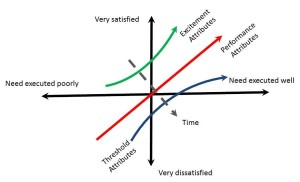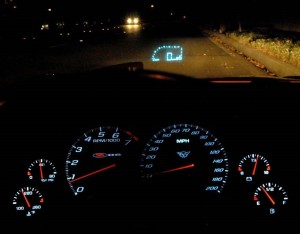Unleashing Engineering Creativity: The Kano Model
How do we decide which features to include in new products? That’s a great question. If we miss important features or include unnecessary features, customers will reject our products. If we include unexpected and exciting features, though, we can delight customers and jump ahead of the competition. Dr. Noriaki Kano addressed this key creativity issue by identifying four product attribute areas:
- Threshold Attributes. These are attributes customers expect without knowing it. They will know when they are absent, though, so they must be included.
- Performance Attributes. Performance attributes are minimum known customer requirements. Design teams certainly need to meet these, but their presence is not sufficient for assuring a competitive advantage.
- Unnecessary Attributes. These are features that customers don’t want. They actually work against a purchase decision because they add complexity and cost.
- Excitement Attributes. In the creativity world, this is where success resides. Excitement attributes surprise and delight customers. When customer experience excitement attributes, the impact is immediate and dramatic: They want the product. These attributes differentiate your product from the competition.
The Kano model shows threshold, performance, and excitement attributes as a function of customer satisfaction:
 The Kano Model. The model shows customer satisfaction for excitement, performance, and threshold attributes as a function of how well each is executed. Excitement attributes offer the greatest customer satisfaction and clear competitive advantages.
The Kano Model. The model shows customer satisfaction for excitement, performance, and threshold attributes as a function of how well each is executed. Excitement attributes offer the greatest customer satisfaction and clear competitive advantages.
The Kano model’s messages are clear:
- Customer dissatisfaction increases sharply when threshold attributes are missing, but when threshold attributes are met, satisfaction doesn’t experience much of an increase. We just don’t get excited when products meet minimum expectations.
- The relationship between customer satisfaction and performance attributes is linear. We get increases in customer satisfaction as we meet performance attributes, but it is not dramatic. Satisfying these expectations is expected, but not exciting.
- Excitement attributes increase customer satisfaction exponentially. We get more bang for our creativity buck as we include well-executed excitement attributes.
- Attributes migrate and have less effect on customer satisfaction over time. This is true for excitement, performance, and threshold attributes, but it is especially true for excitement attributes. What was exciting yesterday is not so exciting tomorrow.
Understanding the different attributes is easier with examples. In the early 1960s, automobile air conditioners and power windows were a big deal; these things were clearly excitement attributes back then. Twenty years ago, paying for gasoline at the pump with a credit card instead of going into the gas station office was new. Ten years ago, high speed Internet was exciting. Today these things are expected; they’ve migrated into performance or perhaps even threshold attributes.
An Excitement Attribute: The 2004 Corvette Heads-Up Display. Excitement attributes elicit positive emotional responses and provide clear competitive advantages.
Consider the Chevy Corvette. When I bought mine, the salesman explained to me how to open the gas cap (the release is hidden). Chevy gets a lot of calls the first time customers fill up their Corvettes. We wouldn’t think about this threshold attribute when making a purchase decision, but when you can’t fill up your car, you’ve run smack into an unmet threshold attribute. Let’s shift to a Corvette excitement attribute, and in particular, one that prompted my purchase decision. I had previously only seen heads-up displays on combat aircraft (these display key information directly in the pilot’s field of view). When I saw a heads-up display in a Corvette, it was unexpected, I was delighted, and it was clearly an excitement attribute. It worked. I bought the car.
To engineers who create new products, the message is clear: We need a constant flow of excitement attributes. We can’t simply add features, though. We need to add the right features. We need ongoing innovation to develop and maintain an excitement-attributes- driven competitive edge. There are many ways we can find excitement attributes, and they are all detailed in the Eogogics Unleashing Engineering Creativity workshop (and the Unleashing Engineering Creativity book that’s part of the workshop but is also sold separately).
If you’d like to learn more about creativity stimulation techniques, check out our Creativity Education Center, which features a whole slew of free resources including articles, podcasts, and videos on the subject of creativity. There is also a video-recorded version of an Unleashing Engineering Creativity mini-workshop I recently taught live. The mini-workshop comes free with Eogogics membership, which is also free. To become a member, visit our website (wwe.eogogics.com) and fill out the short membership form. After you receive your login, you will be able to sign in and request the mini-workshop at no cost.
Editor’s Note: Joe Berk, Principal Eogogics Faculty, teaches the Eogogics engineering design, engineering creativity, product and process improvement, reliability engineering, engineering economics, quality management, and technical management/leadership courses. Before starting to train/consult for us, he held senior management positions in engineering, quality assurance, and manufacturing. He’s the author of ten books on engineering, including Unleashing Engineering Creativity, an Eogogics publication. He holds undergraduate and graduate degrees in mechanical engineering from Rutgers University and an MBA from Pepperdine University.



Sorry, comments for this entry are closed at this time.